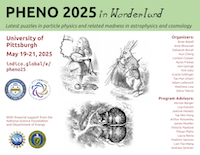Speaker
Description
We are considering a minimal $U(1)_B$ extension of the Standard Model (SM)
by promoting the baryon number as a local gauge symmetry to accommodate a
stable dark matter (DM) candidate. The gauge theory of baryons induces non-
trivial triangle gauge anomalies, and we provide a simple anomaly-free solution
by adding three exotic fermions. A scalar S spontaneously breaks the $U(1)_B$
symmetry, leaving behind a discrete $Z_2$ symmetry that ensures the stability of
the lightest exotic fermion originally introduced to cancel the triangle gauge
anomalies. Scenarios with weakly interacting DM candidates having non-zero
hypercharge usually face stringent constraints from experimental bounds on
the DM spin-independent direct-detection (SIDD) cross-section. In this work,
we consider a two-component singlet-doublet fermionic dark matter scenario,
which significantly relaxes the constraints from bounds on the DM SIDD cross-
section for suppressed single-doublet mixing. We show that the model offers a
viable parameter space for a cosmologically consistent DM candidate that can be
probed through direct detection searches, collider experiments, and gravitational
wave (GW) experiments.

